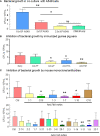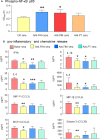Anti-FIM and Anti-FHA Antibodies Inhibit Bordetella pertussis Growth and Reduce Epithelial Cell Inflammation Through Bacterial Aggregation
- PMID: 33384692
- PMCID: PMC7770163
- DOI: 10.3389/fimmu.2020.605273
Anti-FIM and Anti-FHA Antibodies Inhibit Bordetella pertussis Growth and Reduce Epithelial Cell Inflammation Through Bacterial Aggregation
Abstract
The pertussis vaccination is highly recommended for infants, children, and pregnant women. Despite a high coverage of vaccination, pertussis continues to be of public health concern as a re-emerging infectious disease. The mechanism by which vaccine-elicited anti-pertussis antibodies mediate direct bactericidal effects is poorly understood. In this study, we showed that the interaction of B. pertussis with A549 epithelial cells induce release of biological factors which enhance bacteria growth. Complement-depleted antisera from vaccine-immunized guinea pigs or monoclonal antibodies targeting FHA and FIM mediate bacteria aggregation and elicit bactericidal effects. Our in vitro results indicated that aggregation of bacteria through anti-FIM and anti-FHA specific antibodies is one of the major biological mechanisms to clear bacterial infections and restore epithelial cell survival in vitro. Our data also indicates that the anti-pertussis antibodies reduce secretion of proinflammatory chemokines and cytokines by preventing interaction of B. pertussis with host cells. The results of this study not only demonstrate mechanism of action of anti-FIM and anti-FHA antibodies, but also opens translational applications for potential therapeutic approaches or development of analytical assays such as in vitro potency assays.
Keywords: aggregation; anti-pertussis antibodies; bacterial growth inhibition; cytokines; epithelial inflammation.
Copyright © 2020 Yougbare, McTague, He, Choy, Su, Gajewska and Azizi.
Conflict of interest statement
All authors are employees of Sanofi Pasteur.
Figures





Similar articles
-
Invasion of human respiratory epithelial cells by Bordetella pertussis: possible role for a filamentous hemagglutinin Arg-Gly-Asp sequence and alpha5beta1 integrin.Microb Pathog. 2001 May;30(5):279-88. doi: 10.1006/mpat.2001.0432. Microb Pathog. 2001. PMID: 11373122
-
Should fimbriae be included in pertussis vaccines? Studies on ELISA IgG anti-Fim2/3 antibodies after vaccination and infection.APMIS. 2009 Sep;117(9):660-71. doi: 10.1111/j.1600-0463.2009.02521.x. APMIS. 2009. PMID: 19703126 Clinical Trial.
-
Bordetella filamentous hemagglutinin and fimbriae: critical adhesins with unrealized vaccine potential.Pathog Dis. 2015 Nov;73(8):ftv079. doi: 10.1093/femspd/ftv079. Epub 2015 Sep 27. Pathog Dis. 2015. PMID: 26416077 Free PMC article. Review.
-
Interaction of Bordetella pertussis filamentous hemagglutinin with human TLR2: identification of the TLR2-binding domain.APMIS. 2015 Feb;123(2):156-62. doi: 10.1111/apm.12332. Epub 2014 Oct 29. APMIS. 2015. PMID: 25353353
-
Immunoprophylaxis in pertussis.J Commun Dis. 1984 Mar;16(1):54-60. J Commun Dis. 1984. PMID: 12055788 Review.
Cited by
-
Modulation of Inflammatory Signaling Molecules in Bordetella pertussis Antigen-Challenged Human Monocytes in Presence of Adrenergic Agonists.Vaccines (Basel). 2022 Feb 17;10(2):321. doi: 10.3390/vaccines10020321. Vaccines (Basel). 2022. PMID: 35214778 Free PMC article.
-
Monoclonal antibodies: From magic bullet to precision weapon.Mol Biomed. 2024 Oct 11;5(1):47. doi: 10.1186/s43556-024-00210-1. Mol Biomed. 2024. PMID: 39390211 Free PMC article. Review.
-
Virus-like particles displaying the mature C-terminal domain of filamentous hemagglutinin are immunogenic and protective against Bordetella pertussis respiratory infection in mice.Infect Immun. 2024 Aug 13;92(8):e0027024. doi: 10.1128/iai.00270-24. Epub 2024 Jul 18. Infect Immun. 2024. PMID: 39023271 Free PMC article.
-
Development of monoclonal antibodies against P. gingivalis Mfa1 and their protective capacity in an experimental periodontitis model.mSphere. 2025 Jan 28;10(1):e0072124. doi: 10.1128/msphere.00721-24. Epub 2024 Dec 19. mSphere. 2025. PMID: 39699191 Free PMC article.
-
Monoclonal Antibodies for Bacterial Pathogens: Mechanisms of Action and Engineering Approaches for Enhanced Effector Functions.Biomedicines. 2022 Aug 30;10(9):2126. doi: 10.3390/biomedicines10092126. Biomedicines. 2022. PMID: 36140226 Free PMC article. Review.
References
-
- Koepke R, Eickhoff JC, Ayele RA, Petit AB, Schauer SL, Hopfensperger DJ, et al. Estimating the effectiveness of tetanus-diphtheria-acellular pertussis vaccine (Tdap) for preventing pertussis: evidence of rapidly waning immunity and difference in effectiveness by Tdap brand. J Infect Dis (2014) 210:942–53. 10.1093/infdis/jiu322 - DOI - PubMed
MeSH terms
Substances
LinkOut - more resources
Full Text Sources
Medical

